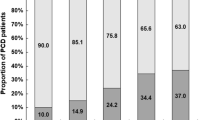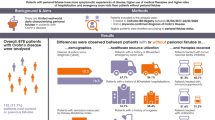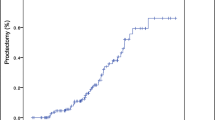Abstract
Background
Little is known about the natural history of perianal fistulas in Asian populations with Crohn’s disease (CD).
Aims
We investigated the incidence and outcomes of perianal CD (pCD) in Korean CD patients.
Methods
A nationwide population-based cohort of 6265 CD patients diagnosed in 2010–2014 was analyzed to investigate the incidence and outcomes of pCD. The results were validated in a hospital-based cohort of 2923 CD patients diagnosed in 1981–2015. Factors associated with pCD development were analyzed. The incidence and outcomes of pCD were compared between the prebiologic and biologic eras.
Results
pCD occurred in 39.2% of the population-based cohort and 56.1% of the hospital-based cohort during the median follow-up of 4.2 and 8.5 years, respectively. The cumulative incidence of pCD was 40.0% at 5 years after CD diagnosis in the population-based cohort and 62.5% at 20 years in the hospital-based cohort. In multivariate analysis, pCD development was positively associated with male sex, younger age and colonic involvement at diagnosis, early diagnosis, and CD diagnosis in the prebiologic era. The cumulative probability of proctectomy at 10, 20, and 30 years after pCD diagnosis was 2.9%, 12.2%, and 16.2%, respectively. The cumulative incidence of pCD occurring after CD diagnosis and the cumulative probability of proctectomy were significantly lower in the biologic era than in the prebiologic era (p < 0.001 and p = 0.03, respectively).
Conclusions
Compared with Western patients with CD, Korean patients show a high incidence of pCD but have a low probability of proctectomy, suggesting the favorable course of pCD.





Similar content being viewed by others
References
Vollebregt PF, van Bodegraven AA, Markus-de Kwaadsteniet TML, van der Horst D, Felt-Bersma RJF. Impacts of perianal disease and faecal incontinence on quality of life and employment in 1092 patients with inflammatory bowel disease. Aliment Pharmacol Ther. 2018;47:1253–1260.
Mahadev S, Young JM, Selby W, Solomon MJ. Quality of life in perianal Crohn’s disease: what do patients consider important? Dis Colon Rectum. 2011;54:579–585.
Bernell O, Lapidus A, Hellers G. Risk factors for surgery and postoperative recurrence in Crohn’s disease. Ann Surg. 2000;231:38–45.
Beaugerie L, Seksik P, Nion-Larmurier I, Gendre JP, Cosnes J. Predictors of Crohn’s disease. Gastroenterology. 2006;130:650–656.
Lakatos PL, Czegledi Z, Szamosi T, et al. Perianal disease, small bowel disease, smoking, prior steroid or early azathioprine/biological therapy are predictors of disease behavior change in patients with Crohn’s disease. World J Gastroenterol. 2009;15:3504–3510.
Kobayashi T, Hisamatsu T, Suzuki Y, et al. Predicting outcomes to optimize disease management in inflammatory bowel disease in Japan: their differences and similarities to Western countries. Intest Res. 2018;16:168–177.
Beaugerie L, Carrat F, Nahon S, et al. High risk of anal and rectal cancer in patients with anal and/or perianal Crohn’s disease. Clin Gastroenterol Hepatol. 2018;16:892–899-e892.
Lee HS, Park SH, Yang SK, et al. The risk of colorectal cancer in inflammatory bowel disease: a hospital-based cohort study from Korea. Scand J Gastroenterol. 2015;50:188–196.
Schwartz DA, Loftus EV Jr, Tremaine WJ, et al. The natural history of fistulizing Crohn’s disease in Olmsted County, Minnesota. Gastroenterology. 2002;122:875–880.
Thia KT, Sandborn WJ, Harmsen WS, Zinsmeister AR, Loftus EV Jr. Risk factors associated with progression to intestinal complications of Crohn’s disease in a population-based cohort. Gastroenterology. 2010;139:1147–1155.
Park SH, Aniwan S, Scott Harmsen W, et al. Update on the natural course of fistulizing perianal Crohn’s disease in a population-based cohort. Inflamm Bowel Dis. 2019;25:1054–1060.
Hellers G, Bergstrand O, Ewerth S, Holmstrom B. Occurrence and outcome after primary treatment of anal fistulae in Crohn’s disease. Gut. 1980;21:525–527.
Gottgens KW, Jeuring SF, Sturkenboom R, et al. Time trends in the epidemiology and outcome of perianal fistulizing Crohn’s disease in a population-based cohort. Eur J Gastroenterol Hepatol. 2017;29:595–601.
Shi HY, Levy AN, Trivedi HD, Chan FKL, Ng SC, Ananthakrishnan AN. Ethnicity Influences phenotype and outcomes in inflammatory bowel disease: a systematic review and meta-analysis of population-based studies. Clin Gastroenterol Hepatol. 2018;16:190–197-e111.
Mak WY, Mak OS, Lee CK, et al. Significant medical and surgical morbidity in perianal Crohn’s disease: results from a territory-wide study. J Crohns Colitis. 2018;12(12):1392–1398.
Chang K, Lee HS, Kim YJ, et al. Increased risk of herpes zoster infection in patients with inflammatory bowel diseases in Korea. Clin Gastroenterol Hepatol. 2018;16:1928–1936-e1922.
Kim HJ, Hann HJ, Hong SN, et al. Incidence and natural course of inflammatory bowel disease in Korea, 2006–2012: a nationwide population-based study. Inflamm Bowel Dis. 2015;21:623–630.
Wei SC. Differences in the public medical insurance systems for inflammatory bowel disease treatment in Asian countries. Intest Res. 2016;14:218–223.
Kim JA, Yoon S, Kim LY, Kim DS. Towards actualizing the value potential of Korea Health Insurance Review and Assessment (HIRA) data as a resource for health research: strengths, limitations, applications, and strategies for optimal use of HIRA data. J Korean Med Sci. 2017;32:718–728.
Park SH, Yang SK, Park SK, et al. Long-term prognosis of Crohn’s disease and its temporal change between 1981 and 2012: a hospital-based cohort study from Korea. Inflamm Bowel Dis. 2014;20:488–494.
Ye BD, Yang SK, Cho YK, et al. Clinical features and long-term prognosis of Crohn’s disease in Korea. Scand J Gastroenterol. 2010;45:1178–1185.
Sjoberg D, Holmstrom T, Larsson M, et al. Incidence and clinical course of Crohn’s disease during the first year—results from the IBD Cohort of the Uppsala Region (ICURE) of Sweden 2005–2009. J Crohns Colitis. 2014;8:215–222.
van den Heuvel TRA, Jeuring SFG, Zeegers MP, et al. A 20-year temporal change analysis in incidence, presenting phenotype and mortality, in the Dutch IBDSL cohort-can diagnostic factors explain the increase in IBD incidence? J Crohns Colitis. 2017;11:1169–1179.
Bell SJ, Williams AB, Wiesel P, Wilkinson K, Cohen RC, Kamm MA. The clinical course of fistulating Crohn’s disease. Aliment Pharmacol Ther. 2003;17:1145–1151.
Acknowledgments
We thank the Korean Health Insurance Review and Assessment Service and the National Health Insurance Service for providing the insurance claims data.
Funding
This work was supported by a Korean Health Technology R&D Project Grant from the Korea Health Industry Development Institute to Suk-Kyun Yang (A120176), funded by the Ministry of Health and Welfare. Ho-Su Lee was supported by the National Research Foundation of Korea (NRF) MRC Grant funded by the Korean government (MSIT) (2018R1A5A2020732).
Author information
Authors and Affiliations
Contributions
EMS, HSL, and SKY were involved in planning and conducting the study. EMS, HSL, YJK, EHO, NSH, JK, SWH, SHP, DHY, BDY, JSB, SJM, YSY, CSY, and SKY contributed to collecting data. EMS, HSL, YJK, and SKY helped in statistical analysis and interpretation of data. EMS and HSL contributed to drafting the manuscript. SKY was involved in study supervision and critical revision of the manuscript for important intellectual content.
Corresponding author
Ethics declarations
Conflict of interest
Suk-Kyun Yang received a research grant from Janssen Korea Ltd.; however, this funding was not related to the topic of this study. The remaining authors have no conflict of interest or financial ties to declare.
Additional information
Publisher's Note
Springer Nature remains neutral with regard to jurisdictional claims in published maps and institutional affiliations.
Rights and permissions
About this article
Cite this article
Song, E.M., Lee, HS., Kim, YJ. et al. Incidence and Outcomes of Perianal Disease in an Asian Population with Crohn’s Disease: A Nationwide Population-Based Study. Dig Dis Sci 65, 1189–1196 (2020). https://doi.org/10.1007/s10620-019-05819-9
Received:
Accepted:
Published:
Issue Date:
DOI: https://doi.org/10.1007/s10620-019-05819-9




